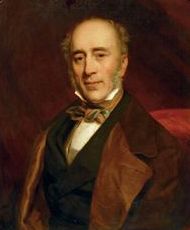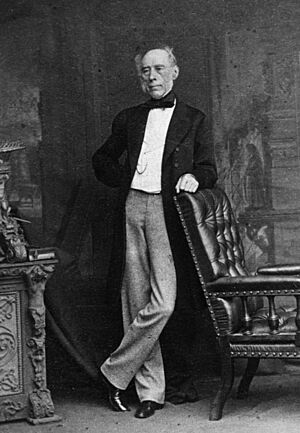Sir James Clark, 1st Baronet facts for kids
Quick facts for kids
James Clark
|
|
|---|---|
 |
|
| Born | 14 December 1788 Cullen, Banffshire, Scotland
|
| Died | Error: Death date (first date) must be later in time than the birth date (second date) Bagshot Park, Surrey, England
|
| Spouse(s) | Barbara Stephen |
| Children | 1 |
Sir James Clark, 1st Baronet (born December 14, 1788 – died June 29, 1870) was a Scottish doctor. He was a special physician to Queen Victoria from 1837 to 1860. Before that, he was the doctor for the famous poet John Keats in Rome.
Contents
Early Life and Medical Career
Sir James Clark was born in a town called Cullen in Scotland. He went to Fordyce School and then to Aberdeen University. He first studied arts, thinking he would become a lawyer. But he soon found he liked medicine more.
He then went to Edinburgh University. In 1809, he became a member of the Royal College of Surgeons of Edinburgh. This meant he was a qualified surgeon.
After his studies, James Clark joined the medical team of the Royal Navy. He worked at a hospital in Hampshire until 1810. Then, he became an assistant surgeon on a ship called HMS Thistle.
In 1811, his ship was wrecked near Sandy Hook. He returned to Great Britain. There, he was promoted to a full surgeon. He served on other ships, including HMS Colobrée, which also got wrecked.
Travels and New Ideas
After the Napoleonic Wars ended in 1815, he continued his studies. He earned his MD degree in Edinburgh in 1817. In 1818, he traveled to the south of France and Switzerland. He was with a patient who had a serious lung disease called tuberculosis.
During his travels, he started collecting information about the weather. He noticed how changes in climate affected his patient's illness. This made him think about how different places could help people get better.
Doctor in Rome
In 1819, James Clark moved to Rome. He started his own medical practice there. His reputation grew, and he became very successful. One of his famous patients was the poet John Keats. Keats came to Rome in November 1820.
Clark first thought Keats's problems were from "mental exertions" and were in his stomach. When he finally realized Keats had tuberculosis, he put him on a very strict diet. Some people now believe that Clark's treatment might have made Keats's final days worse. Keats sadly died in February 1821.
In 1822, while in Rome, Clark wrote a book. It was called Medical Notes on Climate, Diseases, Hospitals, and Medical Schools in France, Italy, and Switzerland. In this book, he wrote about how living in southern Europe could affect people with lung problems.
He also met many important people in Europe. These included members of royal families and nobles. One of them was Prince Leopold, who later became the King of the Belgians. Prince Leopold was very impressed with Clark. When Leopold returned to England, he chose Clark to be his personal doctor.
Return to London
James Clark moved back to London in 1826. He became a doctor at St George's Infirmary. He quickly built a successful medical practice in London. In 1829, he published another important book. It was called The Influence of Climate in the Prevention and Cure of Chronic Diseases.
In this book, he explained how climate and mineral waters could help treat long-term illnesses. He became well-known for his careful way of prescribing medicines. He was elected a Fellow of the Royal Society in 1832. This was a great honor for a scientist.
Physician to Queen Victoria
In 1834, King Leopold suggested Clark to his sister, the Duchess of Kent. The Duchess was the mother of Princess Victoria. This new role greatly increased Clark's fame and business. King Leopold also made him a knight in his own order.
In 1835, Clark published a big book about tuberculosis. On November 11, 1837, Queen Victoria became queen. Six months later, Clark was officially appointed her Physician-in-Ordinary. He was also given the title of baronet, which meant he was now called Sir James Clark.
A Difficult Time
In 1839, Sir James Clark faced a difficult situation. He was asked to examine Lady Flora Hastings, who was unmarried and had a swollen abdomen. Clark couldn't examine her right away, but some people started spreading rumors that she was pregnant. Queen Victoria herself suspected something was wrong.
It was thought at the time that Clark had supported these rumors. When Lady Flora was finally examined, it was found she was not pregnant. She had a serious illness that caused the swelling, and she died a few months later. This event caused a lot of public anger against the Queen and Clark. People felt they had wrongly accused Lady Flora.
This misunderstanding hurt Clark's reputation for some time. However, later in his life, people generally understood that he had been unfairly blamed.
Trusted Advisor
In 1840, Clark also became the doctor for Prince Albert, Queen Victoria's husband. He became a trusted advisor to the royal family on all health matters. He was often at court and highly respected by the Queen and Prince Albert.
He also served on several important government groups. He helped develop the medical section of the University of London. Clark also played a key role in starting the Royal College of Chemistry in 1845. From 1858 to 1860, he served on the General Medical Council.
In 1866, he received another high honor. He was made a Knight Commander of the Order of the Bath (KCB).
Retirement and Passing
Sir James Clark began to retire slowly in 1860. He moved to Bagshot Park in Surrey. Queen Victoria had allowed him to live there for the rest of his life. His wife, Barbara Stephen, whom he called Minnie, passed away in 1862. They had one son, John Forbes Clark.
Sir James Clark passed away at Bagshot Park in 1870. He was 81 years old. He was buried at Kensal Green.
Images for kids



